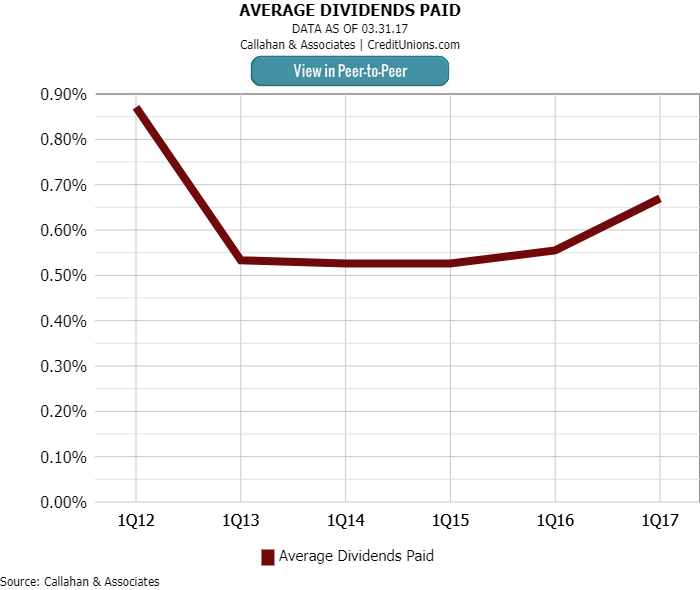The commitment of credit unions to return funds to their member-owners has been growing along with membership rosters.
Callahan & Associates projects dividends for the industry, on an annualized basis, will surpass $6.5 billion in second quarter 2017. The dividends-to-income ratio measures the portion of earnings that credit unions return directly to their members and quantifies, to an extent, the focus an institution places on returning value to its membership.
Two credit unions in different regions of the United States have varying, yet successful, approaches to increasing that ratio.
Star One Credit Union($9.3B,Sunnyvale, CA) and Dow Chemical Employees Credit Union($1.6B,Midland, MI)have exceeded national averages in the past and posted impressive numbers,again,in the second quarter of 2017.ContentMiddleAd
The industry average of dividends-to-income ratio posted second quarter rates at 9.5% and for credit unions with assets between $1 billion and $10 billion, 10.5%; Star One and Dow Chemical Employees reported rates at 28.9% and 25.2%, respectively.
Total dividends at credit unions include both dividends on share accounts and interest paid to consumers on deposits. Star One focuses on the first form, dividends on share accounts, to return value to its members.
Regular shares accounted for 88.8% of Star One’s share portfolio as of second quarter 2017. The industry average is 35.6% for the 5,571 credit unions with data reported in Callahan’s Peer-to-Peer software. At $30 million, Star One pays the entiretyof its reported dividends on share deposits.
The credit union’s average dividend paid as a percentage of shares increased 16 basis points year-over-year to 0.96% in the second quarter of 2017. Average share balances increased $5,551 in the past year to total $62,499. As a result, the creditunion is providing increasing returns to savers that deposit more money with the institution.
A potential operational drawback to this generous return to savers is a high cost of funds.
Catch Up On 2Q 2017 Trendwatch
This must-attend quarterly event for credit union leaders covers performance trends, industry success stories, and areas of opportunity. Attendees will find insight they won’t find anywhere else weeks before the official NCUA datarelease.

The cost of funds ratio represents the expenses an institution incurs on deposits as a percentage of average total shares. At 1.1%, Star One paid depositors 52 basis points more than the national average in the first quarter of 2017. For Star One, thatincreased 5 basis points in the second quarter.
Star One has managed its cost of funds via its 14.3% share growth, which is well above the national average. The total dollar amount of share balances increased $244.7 million since March 31, 2017, evidence Star One is expanding its share portfolio whilepaying more to savers.
Dow Chemical Employees Credit Union, on the other hand, has been steadily increasing its dividend payout ratio through interest paid on consumer deposits.
Regular shares comprised 30.0% of the credit union’s share portfolio as of June 30, 2017. Members at Dow Chemical Employees deposit their money primarily into money market share accounts, which make up 48.6% of the portfolio. Year-to-date, the creditunion has paid $4.5 million in interest on deposits and $483,796 as dividends on shares. The average dividend paid by Dow Chemical Employees increased 12 basis points year-over-year to 0.71% as of June 30, 2017, with average share balances up $785over the same period.
Like Star One, Dow Chemical Employees has a higher cost of funds at 0.74% than both the industry average and the $1 billion-$10 billion asset peer group, at 0.60% and 0.63% respectively, as of second quarter 2017.
The only share account where Dow Chemical has reported an increase in interest rates is share certificates, which increased 35 basis points year-over-year to 1.79% as of June 30, 2017.
Returning profits to member-owners is a founding principle of the credit union movement. Star One and Dow Chemical Employees exemplify this. If interest rates continue to climb in the second half of the year, the cost of funds at credit unions shouldalso increase as members turn to their financial cooperative for greater return on saving. Dividends paid out have a direct correlation with cost of funds, however successful management of increasing these ratios and hence increasing expense, canstill lead to an expanding share portfolio, as these credit unions have shown.



